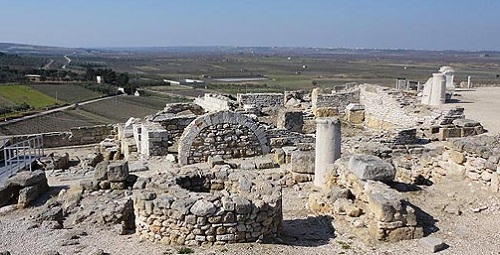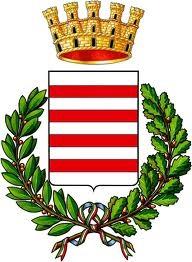|
The city of Barletta has always played a leading role in the history of Puglia.
At the time of the Crusades was one of the most important ports in the Adriatic and a stronghold of the Normans and Lombards, becoming an important staging post for the Crusaders and the Teutonic Knights and Templars as well as the Knights of St.John.
The flow of merchants, pilgrims and soldiers directed in the Middle East made it an important economic center even in the darkest periods in the history of the region.
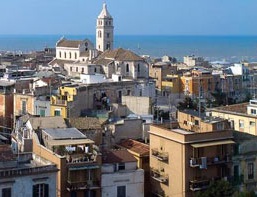 The city experienced its major expansion under the Angevin rule reaching the height of its prosperity under the Aragonesi, who made it the second largest city of the kingdom of Naples, so much so that Ferrante of Aragon wanted to be crowned in his cathedral. The city experienced its major expansion under the Angevin rule reaching the height of its prosperity under the Aragonesi, who made it the second largest city of the kingdom of Naples, so much so that Ferrante of Aragon wanted to be crowned in his cathedral.
At the beginning of the 16th century, during the guerilla war between the French and the Spanish over possession of Southern Italy, the city was the theater of a historical victory of Italian knights over French prisoners, in what became known as the Challenge of Barletta (13 February 1503).
This took place during the occupation of the city by Gonzalo de Cordoba, and served as a handy diversion for his restive siege-bound army. Later the city served as a fortress for the Spanish rulers of southern Italy. In 1528 it was sacked by French troops under Odet de Foix.
In the seventeenth century a terrible plague decimated the population Barlettana and decreed the beginning of the decline of the city that went on for at least two centuries.
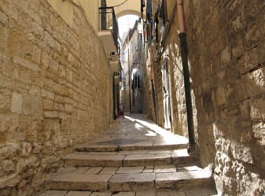 It is not difficult to appreciate the merits of the city of Barletta because everywhere in the labyrinthine alleys of the village as in the broad streets of the center, the focus is often captured by imposing monuments. It is not difficult to appreciate the merits of the city of Barletta because everywhere in the labyrinthine alleys of the village as in the broad streets of the center, the focus is often captured by imposing monuments.
The famous bronze colossus, the cathedral, where Gothic and Romanesque live together in harmony, palaces, Renaissance expression of the best of Puglia, are some of the monuments that the city offers to those who know how to enjoy it.
The cathedral where 4 February 1459, Ferdinand I of Aragon was crowned king of the Kingdom of Naples, was built on the remains of a much bigger and older basilica of which few remains have recently come to light.
In its interior, at a lower level, are grotticella tombs from the 3rd century BC, over which is the Palaeo-Christian basilica (6th century AD) with another basilica being added to that in the 9th century.
In the 12th century a new building was erected in Romanesque style, being consecrated in 1267; this was renewed in Gothic style in the 14th century
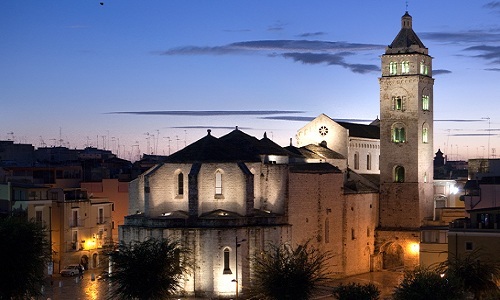 |
The Castle is a structure initially erected in the 10th century by the Normans as a typical motte and bailey structure.
During the Crusade period, it was a used as a hostel for soldiers leaving for the Holy Land. I
t was upgraded and enlarged substantially under the reign of Frederick II between 1225 and 1228.
This corresponds to the period in which he launched a crusade from here, the Sixth Crusade.
In September 1943 it was the setting of an Italian military defence unit against a German army.
The Colossus of Barletta, a large bronze statue of a Roman Emperor.
The nearby Basilica of the Holy Sepulchre (Basilica of San Sepolcro, built in the 12th century) and the former headquarters outside the city walls of the Knights of Malta, it stood next to a hospital for pilgrims (now demolished) to the Holy Land during the medieval period, a Romanesque church with particular Oriental influences from Jerusalem. The façade represents the Baroque style.
Church of San Giacomo (11th century), named after St. John the Great 'Matamoros', was erected on the site of what had been the temple of Isis in Roman times. It was restored an re-consecrated in 1751 shortly after the last disastrous earthquake which destroyed the town of Barletta almost completely.
The Cellar of the Challenge, a former prison for galley slaves.
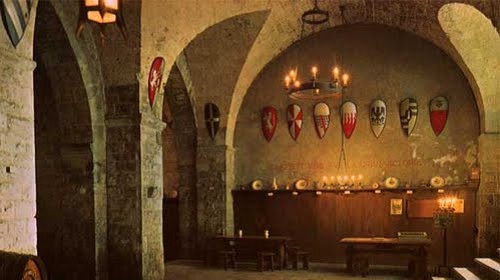 |
| Palace of the Marra, an example of Baroque architecture outside Salento and near the home of the municipal art gallery. |
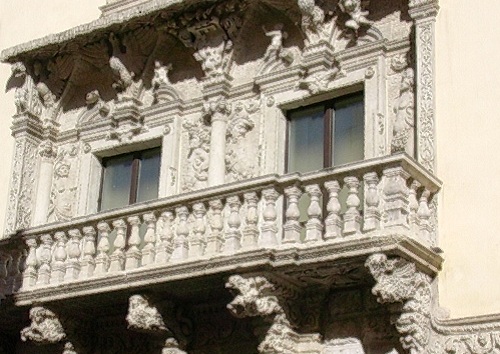 |
Archeological site of the Canne della Battaglia, the location of the Battle of Cannae.
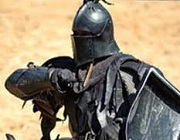 The Challenge of Barletta (Italian: Disfida di Barletta) The Challenge of Barletta (Italian: Disfida di Barletta)
It was a tournament fought in the country of Trani near Barletta, southern Italy, on 13 February 1503, on the plains between Corato and Andria.
The event had its origins in the war for control of the Italian peninsula between France and Spain.
The tournament was provoked by a French knight Charles de la Motte who, after drinking too much of the local wine, made disparaging remarks about the Italians.
As a result, a challenge was thrown down to erase the stain that weighed upon Italian honour.
A group of 13 knights, from various Italian cities and led by Ettore Fieramosca of Capua, accepted the challenge.
The contest lasted from dawn into the night, when the Italians returned victorious to Barletta.
News of the event spread far and wide and the Challenge of Barletta became part of Italian history and Barletta has since acquired the moniker Città della Disfida (City of the Challenge) as a result.
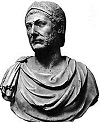 Nearby : Canne. Nearby : Canne.
It is primarily known for the Battle of Cannae, in which the numerically superior Roman army suffered a disastrous defeat by Hannibal in 216 BC (Punic Wars).
There is a considerable controversy as to whether the battle took place on the right or the left bank of the river.
In later times the place became a municipium, and remains of an unimportant Roman town still exist upon the hill known as Monte di Canne.
In the Middle Ages it became a bishopric, and again saw military action in the second battle of Cannae, twelve centuries after the more famous one (1018). The town was destroyed in 1083 by Robert Guiscard.
|


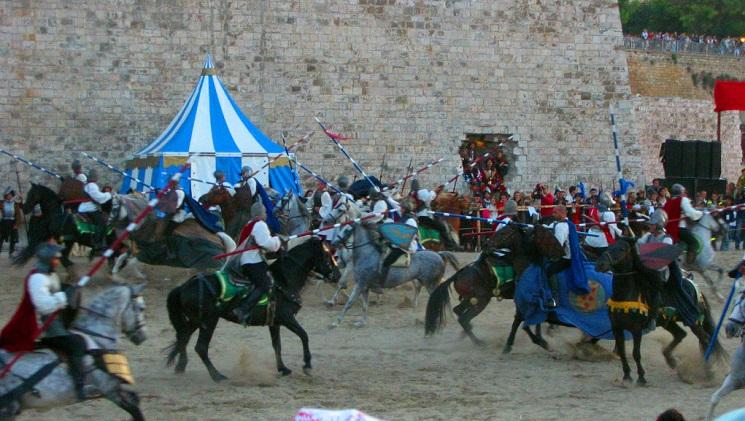
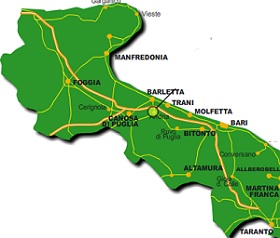 Barulum, its origin dates back one hundred years before the arrival of either in the region, as demonstrated by the finding of an Apulian settlement (4th century BC) and the derivation of its name 'Baal-El' from Phoenician.
Barulum, its origin dates back one hundred years before the arrival of either in the region, as demonstrated by the finding of an Apulian settlement (4th century BC) and the derivation of its name 'Baal-El' from Phoenician.  The city experienced its major expansion under the Angevin rule reaching the height of its prosperity under the Aragonesi, who made it the second largest city of the kingdom of Naples, so much so that Ferrante of Aragon wanted to be crowned in his cathedral.
The city experienced its major expansion under the Angevin rule reaching the height of its prosperity under the Aragonesi, who made it the second largest city of the kingdom of Naples, so much so that Ferrante of Aragon wanted to be crowned in his cathedral.

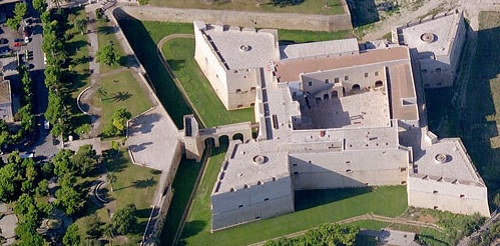
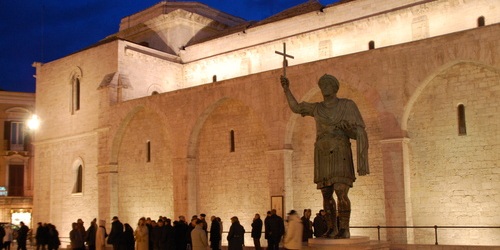
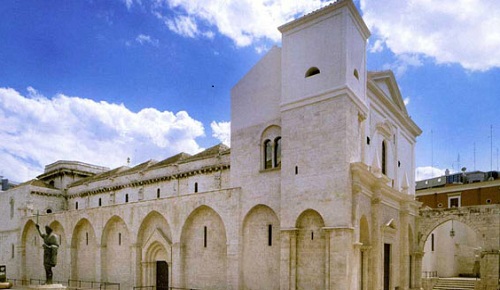
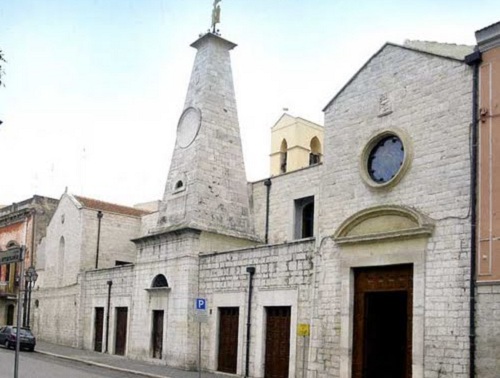


 The Challenge of Barletta (Italian: Disfida di Barletta)
The Challenge of Barletta (Italian: Disfida di Barletta) 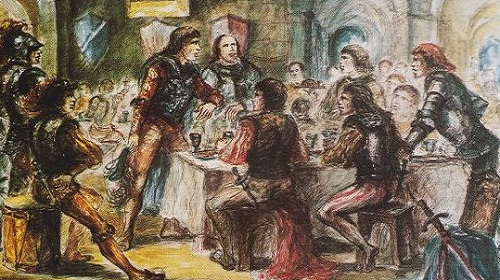
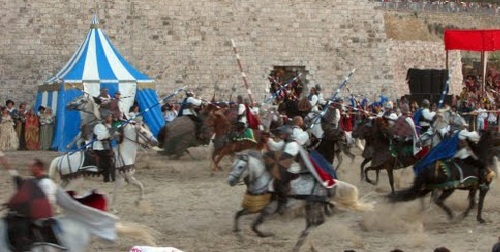
 Nearby : Canne.
Nearby : Canne.